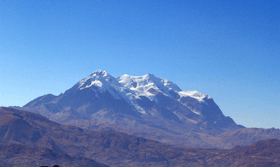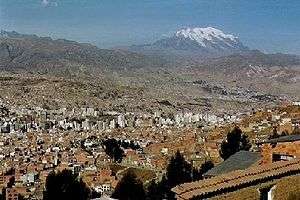Illimani
| Illimani | |
|---|---|
 Illimani in 2005 | |
| Highest point | |
| Elevation | 6,438 m (21,122 ft) [1] |
| Prominence | 2,451 m (8,041 ft) [2] |
| Listing | Ultra |
| Coordinates | 16°38′00″S 67°47′27″W / 16.63333°S 67.79083°WCoordinates: 16°38′00″S 67°47′27″W / 16.63333°S 67.79083°W [2] |
| Geography | |
 Illimani Bolivia | |
| Location | La Paz Department, Bolivia |
| Parent range | Cordillera Real (Andes) |
| Climbing | |
| First ascent | 1898 by William Martin Conway, A. Maquignaz, and L. Pellissier |
Illimani (Aymara) is the highest mountain in the Cordillera Real (part of the Cordillera Oriental, a subrange of the Andes) of western Bolivia. It lies near the cities of El Alto and La Paz at the eastern edge of the Altiplano. It is the second highest peak in Bolivia, after Nevado Sajama, and the eighteenth highest peak in South America.[3] The snow line lies at about 4,570 metres (15,000 ft) above sea level, and glaciers are found on the northern face at 4,983 m (16,350 ft). The mountain has four main peaks; the highest is the south summit, Nevado Illimani, which is a popular ascent for mountain climbers.
Geologically, Illimani is composed primarily of granodiorite, intruded during the Cenozoic era into the sedimentary rock, which forms the bulk of the Cordillera Real.[4]
Illimani is quite visible from the cities of El Alto and La Paz, and is their major landmark. The mountain has been the subject of many local songs, most importantly "Illimani", with the following refrain: "¡Illimani, Illimani, centinela tú eres de La Paz! ¡Illimani, Illimani, patrimonio eres de Bolivia!" ("Illimani, Illimani, you are the sentinel of La Paz! Illimani, Illimani, you are Bolivia's heritage!")
Climbing
Illimani was first attempted in 1877 by the French explorator Charles Wiener, J. de Grumkow, and J. C. Ocampo. They failed to reach the main summit, but did reach a southeastern subsummit, on 19 May 1877, Wiener named it the "Pic de Paris", and left a French flag on top of it.[5] In 1898, British climber William Martin Conway and two Swiss guides, A. Maquignaz and L. Pellissier, made the first recorded ascent of the peak, again from the southeast. (They found a piece of Aymara rope at over 6,000 m (20,000 ft), so an earlier ascent cannot be completely discounted.)[6]
The current standard route on the mountain climbs the west ridge of the main summit. It was first climbed in 1940, by the Germans R. Boetcher, F. Fritz, and W. Kühn, and is graded French PD+/AD-.[6] This route usually requires four days, the summit being reached in the morning of the third day.
In July 2010 German climber Florian Hill and long-time Bolivian resident Robert Rauch climbed a new route on the 'South Face', completing most of the 1700m of ascent in 21 hours. Deliver Me (WI 6 and M6+) appears to climb the gable-end of the South West Ridge, a very steep wall threatened by large broken seracs.[7]
Incidents
Illimani was the site where Eastern Air Lines Flight 980 crashed on January 1, 1985.
See also
Notes
- ↑ This is sometimes given as 6,462 m, but topographic map sources, including a very accurate map by the German Alpine Club, agree that it is 6,438 m. This figure comes from a differential GPS survey; see the reference to World Mountaineering.
- 1 2 "Bolivian ultra-prominent peaks". peaklist.org. Retrieved 2007-04-13.
- ↑ "The 6000m peaks of the Andes". andes.org.uk. Retrieved 2007-04-13.
- ↑ Yossi Brain, Bolivia: a climbing guide, The Mountaineers, 1999, ISBN 0-89886-495-X. Some sources claim that Illimani is an extinct stratovolcano, but this is not correct. In fact none of the peaks of the Cordillera Real are volcanic; see Tom Simkin and Lee Siebert, Volcanoes of the World, a regional directory... (second edition), Smithsonian Institution/Geoscience Press, 1994, ISBN 0-945005-12-1.
- ↑ http://www.persee.fr/web/revues/home/prescript/article/jsa_0037-9174_1919_num_11_1_3822
- 1 2 Lindsay Griffin (1998). "Illimani". In Audrey Salkeld. World Mountaineering. Bulfinch Press. pp. 254–257. ISBN 0-8212-2502-2.
- ↑ "bolivie 2010". pioletsdor.com. Retrieved 2015-11-01.
External links




